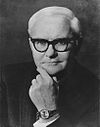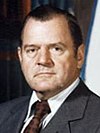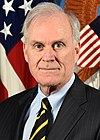The deputy secretary of defense (acronym: DepSecDef) is a statutory office (10 U.S.C. § 132) and the second-highest-ranking official in the Department of Defense of the United States of America.
| United States Deputy Secretary of Defense | |
|---|---|
 Seal of the Department | |
 Flag of the Deputy Secretary | |
| Department of Defense Office of the Secretary | |
| Style | Madam Deputy Secretary (informal) The Honorable (formal) |
| Status | Chief Operating Officer |
| Reports to | Secretary |
| Seat | The Pentagon, Arlington County, Virginia |
| Appointer | The President with Senate advice and consent |
| Term length | No fixed term |
| Constituting instrument | 10 U.S.C. § 132 |
| Formation | 1949[1] |
| First holder | Stephen Early[1] May 2, 1949 |
| Succession | 1st in SecDef succession |
| Salary | Executive Schedule, level II[2] |
| Website | www.defense.gov |
The deputy secretary is the principal civilian deputy to the secretary of defense, and is appointed by the president, with the advice and consent of the Senate. The deputy secretary, by statute, is designated as the DoD chief management officer and must be a civilian, at least seven years removed from service as a commissioned officer on active-duty at the date of appointment.[3]
The current deputy secretary of defense is Kathleen Hicks, effective February 8, 2021. Hicks is the first woman to serve in this role.
History
Public Law 81–36, April 2, 1949, originally established this position as the under secretary of defense, however Public Law 81-2 16, August 10, 1949, a.k.a. the 1949 Amendments to the National Security Act of 1947, changed the title to deputy secretary of defense. Former assistant to President Franklin D. Roosevelt, Stephen Early, became the first officer holder when he was sworn in on May 2, 1949.[1]
Public Law 92-596, October 27, 1972, established a second deputy secretary of defense position, with both deputies performing duties as prescribed by the secretary of defense. The second deputy position was not filled until December 1975. Robert Ellsworth, serving from December 23, 1975, until January 10, 1977, was the only one to ever hold that office. Public Law 95-140, October 21, 1977, established two Under Secretaries of Defense and abolished the second deputy position.[1]
Responsibilities
By delegation, the deputy secretary of defense has full power and authority to act for the secretary of defense and to exercise the powers of the secretary of defense on any and all matters for which the secretary is authorized to act pursuant to statute or executive order.[1] The deputy secretary is first in the line of succession to the secretary of defense.
The typical role of the deputy secretary of defense is to oversee the day-to-day business and lead the internal management processes of the $500-billion-plus Department of Defense budget, that is as its chief operating officer; while the secretary of defense as the chief executive officer focuses on the big issues of the day, ongoing military operations, high-profile congressional hearings, attending meetings of the National Security Council, and directly advising the president on defense issues.
Prior to February 1, 2018, the deputy secretary of defense also served as the department's chief management officer, to whom the deputy chief management officer reported, but those responsibilities were split into a new chief management officer of the Department of Defense position (disestablished on 1 January 2021).[4]
The deputy secretary, among the office's many responsibilities, chairs the Senior Level Review Group (SLRG), before 2005 known as Defense Resources Board (DRB), which provides department-wide budgetary allocation recommendations to the Secretary and the President. Traditionally, the deputy secretary has been the civilian official guiding the process of the Quadrennial Defense Review (QDR).
The deputy secretary of defense chairs the Special Access Program Oversight Committee (SAPOC), which has oversight responsibilities and provides recommendations with respect to changes in status of the Department's Special Access Programs, for either the deputy secretary defense or the secretary of defense to make.
As James Mattis was selecting officials as Donald Trumps first Secretary of Defense, Michèle Flournoy talked with Trump-affiliated officials about joining as deputy secretary. She did not in the end do so.
List of deputy secretaries of defense
| No. | Image | Name | Term of office | Serving under Secretaries of Defense | Appointed by President | ||
|---|---|---|---|---|---|---|---|
| Began | Ended | Time in office | |||||
| 1 |  | Stephen Early | May 2, 1949 August 10, 1949[1] | August 9, 1949[a] September 30, 1950[b][1] | 1 year, 151 days | Louis A. Johnson George C. Marshall | Harry S. Truman |
| 2 |  | Robert A. Lovett | October 4, 1950 | September 16, 1951 | 316 days | George C. Marshall | |
| 3 |  | William Chapman Foster | September 24, 1951 | January 20, 1953 | 1 year, 118 days | Robert A. Lovett | |
| 4 |  | Roger M. Kyes | February 2, 1953 | May 1, 1954 | 1 year, 88 days | Charles Erwin Wilson | Dwight D. Eisenhower |
| 5 |  | Robert B. Anderson | May 3, 1954 | August 4, 1955 | 1 year, 93 days | ||
| 6 |  | Reuben B. Robertson Jr. | August 5, 1955 | April 25, 1957 | 1 year, 263 days | ||
| 7 |  | Donald A. Quarles | May 1, 1957 | May 8, 1959 | 2 years, 7 days | Charles Erwin Wilson Neil H. McElroy | |
| 8 |  | Thomas S. Gates Jr. | June 8, 1959 | December 1, 1959 | 176 days | Neil H. McElroy | |
| 9 |  | James H. Douglas Jr. | December 11, 1959 | January 24, 1961 | 1 year, 44 days | Thomas S. Gates Jr. Robert McNamara | |
| 10 |  | Roswell Gilpatric | January 24, 1961 | January 20, 1964 | 2 years, 361 days | Robert McNamara | John F. Kennedy |
| 11 |  | Cyrus Vance | January 28, 1964 | June 30, 1967 | 3 years, 153 days | Lyndon B. Johnson | |
| 12 |  | Paul Nitze | July 1, 1967 | January 20, 1969 | 1 year, 203 days | Robert McNamara Clark Clifford | |
| 13 |  | David Packard | January 24, 1969 | December 13, 1971 | 2 years, 323 days | Melvin Laird | Richard Nixon |
| 14 |  | Kenneth Rush | February 23, 1972 | January 29, 1973 | 341 days | ||
| 15 |  | Bill Clements | January 30, 1973 | January 20, 1977 | 3 years, 356 days | Elliot Richardson James R. Schlesinger Donald Rumsfeld | |
| 16 |  | Robert Ellsworth | December 23, 1975[5] | January 10, 1977[5] | 1 year, 18 days | Donald Rumsfeld | Gerald Ford |
| 17 |  | Charles Duncan Jr. | January 31, 1977 | July 26, 1979 | 2 years, 176 days | Harold Brown | Jimmy Carter |
| 18 |  | W. Graham Claytor Jr. | August 24, 1979 | January 16, 1981 | 1 year, 145 days | ||
| 19 |  | Frank Carlucci | February 4, 1981 | December 31, 1982 | 1 year, 330 days | Caspar Weinberger | Ronald Reagan |
| 20 |  | W. Paul Thayer | January 12, 1983 | January 4, 1984 | 357 days | ||
| 21 |  | William Howard Taft IV | February 3, 1984 | April 22, 1989 | 5 years, 78 days | Caspar Weinberger Frank Carlucci Dick Cheney | |
| 22 |  | Donald J. Atwood Jr. | April 24, 1989 | January 20, 1993 | 3 years, 271 days | Dick Cheney | George H. W. Bush |
| 23 |  | William Perry | March 5, 1993 | February 3, 1994 | 335 days | Les Aspin | Bill Clinton |
| 24 |  | John M. Deutch | March 11, 1994 | May 10, 1995 | 1 year, 60 days | William Perry | |
| 25 |  | John P. White | June 22, 1995 | July 15, 1997 | 2 years, 23 days | William Perry William Cohen | |
| 26 |  | John Hamre | July 29, 1997 | March 31, 2000 | 2 years, 246 days | William Cohen | |
| 27 |  | Rudy de Leon | March 31, 2000[6] | March 1, 2001[6] | 335 days | William Cohen Donald Rumsfeld | |
| 28 |  | Paul Wolfowitz | March 2, 2001[7] | May 13, 2005[7] | 4 years, 72 days | Donald Rumsfeld | George W. Bush |
| 29 |  | Gordon R. England | May 13, 2005 January 4, 2006[7] | January 3, 2006[c] February 11, 2009[7] | 236 days 1134 | Donald Rumsfeld Robert Gates | |
| 30 |  | William J. Lynn III | February 12, 2009[7] | October 5, 2011[7] | 2 years, 235 days | Robert Gates Leon Panetta | Barack Obama |
| 31 |  | Ash Carter | October 6, 2011[7] | December 4, 2013[7] | 2 years, 58 days | Leon Panetta Chuck Hagel | |
| — |  | Christine Fox Acting | December 5, 2013[7] | May 1, 2014[7] | 149 | Chuck Hagel | |
| 32 |  | Robert O. Work | May 1, 2014 | July 14, 2017 | 3 years, 74 days | Chuck Hagel Ash Carter Jim Mattis | |
| 33 |  | Patrick M. Shanahan | July 19, 2017 | June 23, 2019[8] | 1 year, 339 days | Jim Mattis Himself (acting) | Donald Trump |
| — |  | David Norquist Acting | January 1, 2019 | July 23, 2019 | 203 days | Patrick M. Shanahan (acting) Mark Esper (acting) Richard V. Spencer (acting) | |
| — |  | Richard V. Spencer Acting | July 23, 2019 | July 31, 2019 | 8 days | Mark Esper | |
| 34 |  | David Norquist | July 31, 2019 | February 8, 2021 | 1 year, 192 days | Mark Esper Lloyd Austin | |
| 35 |  | Kathleen Hicks | February 8, 2021 | Incumbent | 3 years, 61 days | Lloyd Austin | Joe Biden |
See also
- Defense Acquisition Board
- Defense Policy Board Advisory Committee
- Deputy's Advisory Working Group, a panel chaired by the deputy secretary of defense
- Packard Commission
Notes
References
Citations
Sources
- Department of Defense Directive 5100.1: Functions of the Department of Defense and Its Major Components (PDF). Department of Defense Directive. Washington, D.C.: U.S. Department of Defense. December 21, 2010. Archived from the original (PDF) on March 22, 2011.
- Department of Defense Key Officials 1947–2015 (PDF). Washington, D.C.: Office of the Secretary of Defense, Historical Office. 2015.
- deputy secretary of defense position profile at Prunes Online
